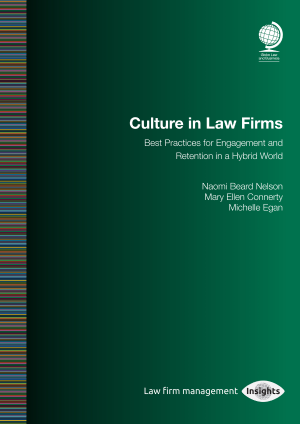Culture in Law Firms: Best Practices for Engagement and Retention in a Hybrid World
ISBN13: 9781787429284
Published: March 2024
Publisher: Globe Law and Business
Country of Publication: UK
Format: A4 Paperback
One of the most notable after-effects of the COVID-19 pandemic is the impact it has had on the way we work. Gone are days of predominantly office-based roles with occasional at-home working – during the pandemic, law firms found myriad ways to keep ‘business as usual’ in an all-remote environment. Fast-forward to 2023 and all law firms have embraced some state of hybrid working culture which presents a further challenge: how to combine the flexibility of remote working with the benefits of bringing people back together in person.
Culture in Law Firms examines how this rapid shift has affected law firms, explores post-pandemic law firm management trends, and explains how law firm leaders can cultivate strong bonds within the firm and with clients, as well as retain and engage top talent. Crucial to all this is the integration of effective diversity, equity and inclusion (DE&I), wellbeing and engagement strategies.
This Special Report looks at the lessons learned during the pandemic and how they can help refine law firm management approaches to:
- Culture: Just as law firms tried to build a sense of culture during all-remote work, they continue to grapple with evolving strategies to foster a dynamic hybrid environment. Relationship- and firm-building are critical to this and the authors explore how many firms, as part of the ‘return-to-office’ pitch, have sought to articulate (i) what’s unique about their workplace; and (ii) how some level of in-person work is essential to forging strong relationships between colleagues and clients
- DE&I: The authors explore to what extent firms are developing their return-to-office diversity and inclusion strategies and how this is underpinned by increased productivity and engagement from staff who are adequately equipped to balance work responsibilities with, for example, parenting, caring for older relatives or personal needs
- Wellbeing: A true sense of inclusion and belonging is intrinsically linked with a sense of wellbeing, and the pandemic significantly increased awareness of the importance of employees’ physical and mental health. The need for workplaces to embrace and support employee wellbeing is considered in this report, and a spotlight is shone on current best practices for advancing wellbeing in a high-intensity law firm environment
Culture in Law Firms offers unique insights and expert guidance for senior law firm management (including managing partners, chairs, executive committee members, c-suite professionals and HR departments) as they navigate the ‘new normal’ to develop robust strategies for the hybrid workplace and beyond.
